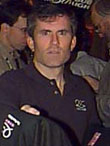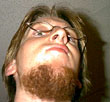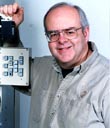Back from the 2-day SMPTE event--but man did it feel like 3 full days worth.Below you will read details of the event as posted by Jim Mendrala over at tech-notes (http://www.Tech-Notes.tv). But I will add my 2-cents worth first.
The demo's were pretty good. The digital, I will have to admit, looked good. Did it look better than film, no. Were the digital and film projectors perfectly matched, no. If this was supposed to show off the best of both, then a better match should have been set-up. The digital projector was brighter and the image was slightly larger (more spill onto masking, which created very sharp edges all around compared to film). Did the digital have solid blacks, no--this was clearly visible when Space Cowboys began in black and white (first reel was digital). Blacks still cannot be produced, yet. And to my eye, green is still not the proper green--which means other colors are effected as well. The images from the Kinoton projector were just rock steady solid. The edges were softer due to barely any over spill on the masking. With these minor difference that were clearly noticable, the "which is better" debate will surely go on.
Of note, the Pacific Theatre is a wonderful wonderful old movie palace. It was designed to be built as the west coast showcase theatre for Warner Bros. It was supposed to open with the premiere of the first talkie movie, "The Jazz Singer," but was not finished in time (it opened with "Glorius Betsy" in 1928). The main floor has about 1100 seats. The balcony suffered much damage in the 1994 earthquake so is not usable. Matter of fact, the theatre is no longer in operation but instead is used as a testing facility.
Things not posted in the comments below include the sound formats. The sound ranged from: mono, LTRT, Dolby SR, Dolby Digital, 6 track discrete, and MOS (that is if you really want to count MOS as sound,  ) and sounded pretty good.
) and sounded pretty good.
Here is a list of the equipment used:
- TI Cinema-grade prototype DLP w/6,000 Christie Lamphouse
- Kinoton 35/70 60PKE
- Uncompressed HD, "Moviestore" digital disk recorder from Avica Technology
- QuVis QuBit Digtial Disk Recorder
- Panasonic Model 2000/2700 D-5 Tape Deck
- Dolby 650
- THX 1138 crossover
- JBL 5674, left, center right powered by Crown
- 8 JBL 3677 used for surrounds
- 4 JBL dual 18" subs
As a little extra item, the final demo was a reel of the upcoming re-release of Apocolypse Now Redux in dye-transfer. And it looked fantastic--especially considering the 22 years on it. The colors were solid.
Here now is Jim's comments:
Subject: 2001 SMPTE Seminar – The Cinema – Now and the Future
By: Jim Mendrala
The Seminar was held at the Digital Cinema Lab at the Entertainment
Technology Center which is the old Pacific Hollywood Theatre located on
Hollywood Boulevard between Wilcox and Cahuenga in the heart of Hollywood
California, USA.
It was supposed to be a realistic look at the evolution of cinema production
and exhibition by and for the people making cinema history. A lot of the
attendees came to learn how these advances can be managed in order to obtain
the greatest quality, speed of operations and cost efficiencies.
On Friday, May 18th, a Film and Digital screening of the film “Space Cowboys”
was run. Alternating the reels between film and digital projection. The
digital projection originated from a Spirit transfer of the IP (Inter
Positive) directly to a QuVis Qubit. The resultant file was about 30 Gbs for
the whole movie. Color timing of the movie for the digital projection was
dome by Jon Yarborough at Warners Bros.. Technicolor supplied a forth
generation “release” print for the film projection. (Original negative to a
timed IP, then to an Intermediate Negative, then to a “release” print.) This
was probably the most unique demonstration of film and digital cinema. Those
seated in the rear half of the auditorium were hard put to tell the
differences. Many turned around during the performance to see what was
running, film or digital. Those seated in the front half of the auditorium,
generally speaking, had no difficulty in detecting which was film and which
was digital. All agreed that the performance was certainly acceptable but
many said it was not as good as it could be.
The next day Saturday, May 19th, Jerry Peirce, Senior VP of Technology at
Universal gave the keynote address titled “The Big Picture”. His keynote
address outlined and skimmed the surface of what digital cinema is all about.
Following Jerry Pierce was Allen Daviau, ASC who gave an introduction
to “Image Acquisition” from a cinematographer’s viewpoint. He spoke about how
the cinematographer does much more than just acquires an image and how a film
is storyboarded, photographed to create the “Look” and generally follows the
production as far as he is able so that the producer and director get what
they want.
After the introduction a panel of 8 well known cinematographers were seated
and after the usual introductions discussed their own ideas of where this new
technology might lead. Bob Fisher a journalist and author moderated the
panel. The panelists were: Allen Daviau, ASC, Stephen Goldblatt, ASC, John
Hora, ASC, Lazilo Kovacs, ASC Hiro Narita, ASC, Mikael Saloman, ASC, Aaron
Schneider, ASC and Nancy Schrieber, ASC. Most panelists showed some film
clips of projects they have been involved on. All were from the ASC (American
Society of Cinematographers).
Tom Scott, VP Engineering and CTO of Ednet, Inc. and SMPTE Engineering
Director for Film gave a DC28 – SMPTE Study Group Report on Digital Cinema.
He stated that some of the study groups are requesting to become working
groups so that the process of setting up engineering guidelines, recommended
practices and standards can start to be formed. All are invited to
participate in the discussion of the various committees.
Demonstrations in the theatre, which has a 55 foot wide screen, showed
examples of digital transfers and the “makings of” on the use of digital
techniques for film release were shown.
The afternoon session was kicked off by Leon Silverman, Executive VP, Laser
Pacific Media Corp. He gave an overview on the Post Production Process. A
panel of three participants, Michael Fink, Senior Visual Effects Supervisor
for Cinesite, Donald Petrie, Director and Sarah Preistnall, Business
Development Director for Eastman Kodak Entertainment Imaging. The panel was
moderated by James Korris, Executive Director and CEO of USC School of
Cinema and Television. Some interesting digitally generated film clips
showing some of the “before and after” images run through Cinesite were
shown.
Ira Lichtman, Director, Walt Disney Imagineering – R&D, Inc. Introduced the
topic of Projection. C. Chapin Cutler, President of Boston Light & Sound gave
a short talk on the PK 60 E film projector installed in the ETC/USC digital
cinema lab. The projector without the typical Maltese cross sets a new
standard for perfect picture performance. The electronic sproket drive is
precisely designed to optimize picture steadiness, focus, contrast and light
transmission to the large screen. The projector features a longer dwell time
thus allowing for a faster pull down and thus allows more light to pass
through each frame.
Bill Werner, Product Development Manager, DLP Cinema Products, Texas
Instruments, Inc. gave an overview of DLP and touched on how the digital
micromirror device (DMD) works. This was followed by a demonstration of
selected takes out of numerous films that have been presented digitally over
the past two years.
The Seminar then went into the topic of Distribution and Exhibition. Bob
Lambert, Senior VP, New Technology& New Media Group, The Walt Disney Company,
was the moderator of a panel of 5 people involved in the motion picture
businesses. They were: J. Wayne Anderson, Chairman and President & CEO, R/C
Theatres and spoke person for NATO, Phil Barlow, Executive VP, Walt Disney
Motion Pictures Group, Mat Erixson, Head of Technical Operations, Advanced
Media Technology Lab, Swedish Royal Institute of Technology, and Thomas McGrath,
Executive VP, Viacom Entertainment Group. Of the group, Phil Barlow and Thomas McGrath had the most
to say. They had opposing viewpoints on several items and when asked
questions from the audience seemed to use the opportunity to talk about more
of their own viewpoints.
The day came to an end with a demonstration of the best film has to offer and
the best of what digital has to offer.
In summary a lot of people attending came with the expectation of learning
something about digital cinema but were probably left just as confused as
when they came. There was no attempt to explain the workings of the various
bits and pieces of the digital cinema processes. Nothing on how films are
scanned and digitized. Nothing on how the various projector technologies,
such as D-ILA, Grating Light Valve and fLCD work. Nothing on some of the
various compression systems, such as QuVis’ QuBit with Wavelet technology,
MPEG or Technicolor/Qualcomm’s variable block DCT that are now or will be
used in the near future. Nothing on how the various delivery systems proposed
work in delivering a movie to a theatre. No mention of any of the encryption
algorithms that might be used to prevent piracy. The Seminar skimmed the
surface and I think created more questions then produced answers. The clips
were interesting and pretty but none were scientific.
Just prior to the SMPTE Seminar the Large Format Imaging Conference was held.
I was reported that one of the 70 mm producers showed a film that went from
2 pixels on up through 4K (4,000) pixels with the idea that you as an
observer determine what would be the necessary number of pixels for the
cinema. Most agreed that 4K were the minimum number of pixels needed. As
easy as that film clip was done none were shown at the SMPTE Seminar. J.
Wayne Anderson said “Theaters would like to have a better product but so far
the studios have not delivered”. Maybe the time is ripe for digital cinemas
to make that happen and provide an incentive for more people to become
theater goers.
The ETC/USC lab has the TI DLP Cinema projector with the “black” chips and
its resolution is 1024 x 1280. Rumor has it that TI will release a 1920 x
1080 chip by the end of the year. We’ll see if that rumor becomes a reality.
Kodak, meanwhile, has a prototype projector using the JVC D-ILA that has 2K
resolution. No one has seen, except in the lab, the Laser CRT nor the Grating
Light Valve.
That’s my report on the 2001 SMPTE Seminar about the Cinema. . Sponsored by
Eastman Kodak Company and the Entertainment Industry Development Corporation
(EIDC).

 Home
Home
 Products
Products
 Store
Store
 Forum
Forum
 Warehouse
Warehouse
 Contact Us
Contact Us




 Printer-friendly view of this topic
Printer-friendly view of this topic









 Wish I could be somewhere in the front rows of that huge theatre.
Wish I could be somewhere in the front rows of that huge theatre.

 What type of digital projection equipment are they using? DLP? ILA? Something else? Will the movie be stored in compressed form on a Qubit (as the 30-odd DLP-equipped theatres are presently doing) or in some less-compressed format or completely uncompressed?
What type of digital projection equipment are they using? DLP? ILA? Something else? Will the movie be stored in compressed form on a Qubit (as the 30-odd DLP-equipped theatres are presently doing) or in some less-compressed format or completely uncompressed?



